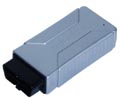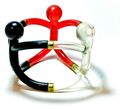DSC5.7 Dynamic Stability Control (E65)
Dynamic Stability Control (DSC)
The DSC calculates the actual movement of vehicle on the basis of measured data and compares it with a defined ideal. By so doing, it establishes whether the vehicle is following the course intended by the driver. If an unstable condition is detected, the DSC keeps the vehicle under control by throttling back the engine and/or operating the brakes on individual wheels. Intervention on the part of the DSC takes precedence over ABS and ASC activity.
Anti-lock braking system - ABS
The purpose of the ABS is to maintain vehicle handling stability under braking.
· The wheel speed sensors detect when a wheel is about to lock up. This is then prevented by modulation of the brake pressure.
· The steering angle, yaw rate and lateral acceleration data is used to detect if the handling of the vehicle has become unstable. By actively increasing or reducing the braking force applied to individual wheels (overriding the actions of the driver) handling of the vehicle dynamics are stabilized.
· Specifically at speeds up to 60 km/h in conditions where there are variations in the frictional coefficient, individual control of rear-wheel braking according to conditions can achieve shorter braking distances.
In the event of failure of the DSC sensor systems or CAN faults, only the ABS remains functional.
Automatic Stability Control (ASC)
The ASC controls the behavior of a wheel that is about to spin in order to maintain the handling stability of the vehicle. This is done by reducing the engine power and braking the spinning wheel.
The ASC dynamic traction-control (DTC) mode is used to improve power transmission when driving in a straight line on a road surface with low grip. This is achieved by varying the ASC response thresholds up to a speed of 70 km/h.
Engine Drag Control (MSR)
Abrupt load changes on the drive train can have a braking effect on the rear wheels which can cause a rear wheel skid. The MSR function counteracts this effect by slightly increasing the drive torque. The MSR function is active above a minimum speed of 15 km/h. If the DSC is deactivated manually or as the result of a fault, the MSR is not functional either.
Dynamic Brake Control (DBC)
Sufficiently rapid application of the brakes by the driver is interpreted by the system as an emergency stop. It then actively increases the brake pressure until the ABS is activated on all four wheels. If the driver reduces the pressure applied to the brake pedal, the hydraulic assistance is proportionately reduced.
Cornering Brake Control (CBC)
CBC increases the driving stability in the case of light braking in curves with medium to high lateral acceleration. It does so by reducing the braking force on the rear wheel that is on the inside of the bend. CBC comes into action before the ABS or DSC. If the DSC fails, the CBC remains functional. The CBC is only deactivated if there is an ABS failure.
Electronic brake force distribution (EBV)
EBV prevents the ABS coming into action on the rear wheels before the front wheels when braking. This ensures greater driving stability. In the event of an ABS failure, the emergency EBV function prevents excess braking of the rear wheels even if the signals from up to two wheel speed sensors or the pressure sensor have been lost.
Parking brake
When the engine is running, operation of the parking brake is performed hydraulically with the aid of the DSC system. If the ASC/DSC fails; only the (Automatic Hold) function is lost. The remaining hydraulic functions remain available unless the ABS fails. For a more detailed description, refer to the description of the parking brake function.
Electronically Controlled Deceleration (ECD)
When the ACC is active, deceleration commands are issued which are carried out by the DSC. When doing so, the DSC also switches on the brake lights.
Engine torque reduction in response to overheating brakes
The brake temperature is calculated by the DSC control unit individually for all four discs. The input variables used are the wheel speed, the individual brake pressure for each wheel, time and ambient temperature.
At brake temperatures upwards of about 600 Deg C, the brakes are protected against overheating by
· limiting engine torque
· preventing action of differential locks on individual wheels
· Not allowing symmetrical braking torque on the relevant pair of wheels.
Once the brake temperature drops below approx. 500 Deg C, the engine torque is allowed to gradually increase again over time and intervention by the control systems is allowed again.
If the brake temperature has exceeded 600 Deg C, an entry is made in the fault memory. This is for the information of the service department - not that there has been a fault, but that a safety mechanism has been activated.
is one of the best Professional scan tools to for BMW; Autohex allows you to diagnose, code, program/flash ecus, and add new keys for BMW. For more information: BMW Scan Tool
BMW Key Programming by HTag Pro, All keys lost


